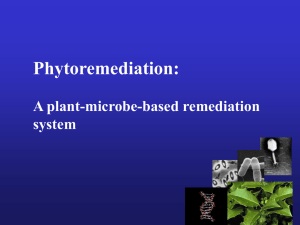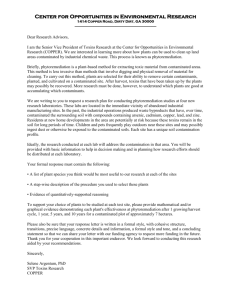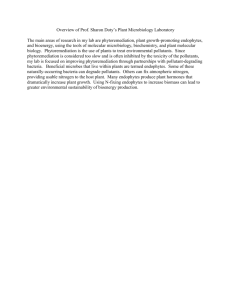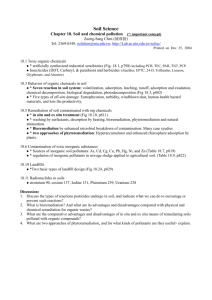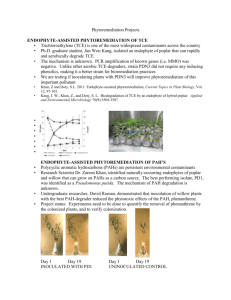IRJET- Treatment of Waste Water by the Process of Phytoremediation using Sunflower Plant
advertisement
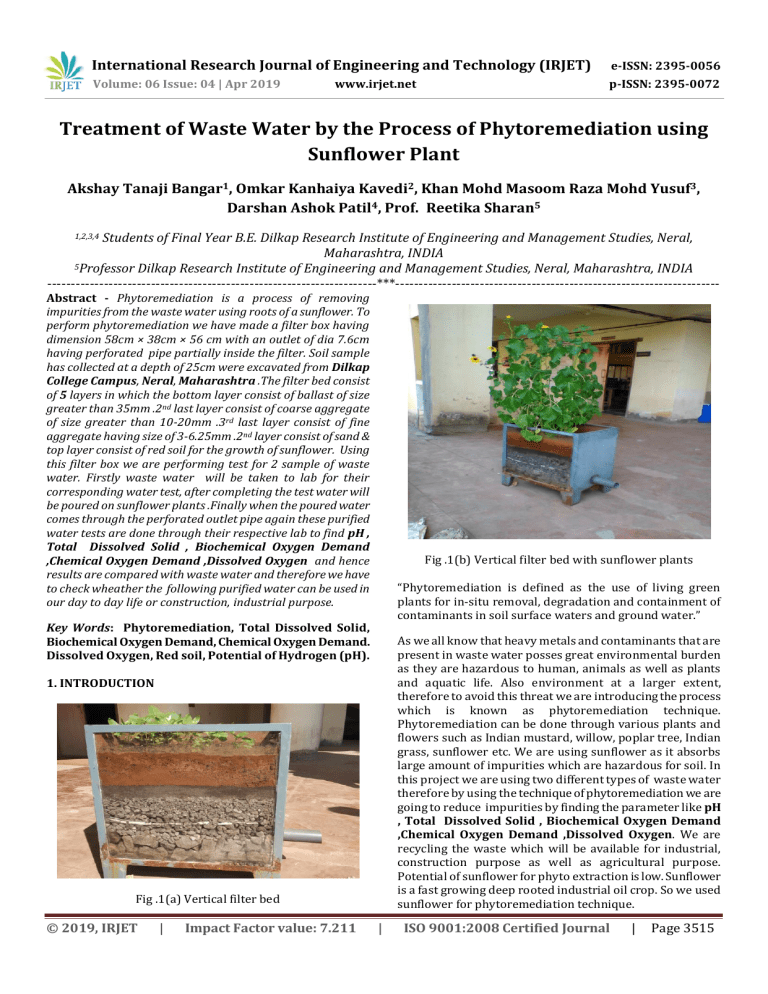
International Research Journal of Engineering and Technology (IRJET) e-ISSN: 2395-0056 Volume: 06 Issue: 04 | Apr 2019 p-ISSN: 2395-0072 www.irjet.net Treatment of Waste Water by the Process of Phytoremediation using Sunflower Plant Akshay Tanaji Bangar1, Omkar Kanhaiya Kavedi2, Khan Mohd Masoom Raza Mohd Yusuf3, Darshan Ashok Patil4, Prof. Reetika Sharan5 Students of Final Year B.E. Dilkap Research Institute of Engineering and Management Studies, Neral, Maharashtra, INDIA 5Professor Dilkap Research Institute of Engineering and Management Studies, Neral, Maharashtra, INDIA ----------------------------------------------------------------------***--------------------------------------------------------------------1,2,3,4 Abstract - Phytoremediation is a process of removing impurities from the waste water using roots of a sunflower. To perform phytoremediation we have made a filter box having dimension 58cm × 38cm × 56 cm with an outlet of dia 7.6cm having perforated pipe partially inside the filter. Soil sample has collected at a depth of 25cm were excavated from Dilkap College Campus, Neral, Maharashtra .The filter bed consist of 5 layers in which the bottom layer consist of ballast of size greater than 35mm .2nd last layer consist of coarse aggregate of size greater than 10-20mm .3rd last layer consist of fine aggregate having size of 3-6.25mm .2nd layer consist of sand & top layer consist of red soil for the growth of sunflower. Using this filter box we are performing test for 2 sample of waste water. Firstly waste water will be taken to lab for their corresponding water test, after completing the test water will be poured on sunflower plants .Finally when the poured water comes through the perforated outlet pipe again these purified water tests are done through their respective lab to find pH , Total Dissolved Solid , Biochemical Oxygen Demand ,Chemical Oxygen Demand ,Dissolved Oxygen and hence results are compared with waste water and therefore we have to check wheather the following purified water can be used in our day to day life or construction, industrial purpose. Fig .1(b) Vertical filter bed with sunflower plants “Phytoremediation is defined as the use of living green plants for in-situ removal, degradation and containment of contaminants in soil surface waters and ground water.” Key Words: Phytoremediation, Total Dissolved Solid, Biochemical Oxygen Demand, Chemical Oxygen Demand. Dissolved Oxygen, Red soil, Potential of Hydrogen (pH). As we all know that heavy metals and contaminants that are present in waste water posses great environmental burden as they are hazardous to human, animals as well as plants and aquatic life. Also environment at a larger extent, therefore to avoid this threat we are introducing the process which is known as phytoremediation technique. Phytoremediation can be done through various plants and flowers such as Indian mustard, willow, poplar tree, Indian grass, sunflower etc. We are using sunflower as it absorbs large amount of impurities which are hazardous for soil. In this project we are using two different types of waste water therefore by using the technique of phytoremediation we are going to reduce impurities by finding the parameter like pH , Total Dissolved Solid , Biochemical Oxygen Demand ,Chemical Oxygen Demand ,Dissolved Oxygen. We are recycling the waste which will be available for industrial, construction purpose as well as agricultural purpose. Potential of sunflower for phyto extraction is low. Sunflower is a fast growing deep rooted industrial oil crop. So we used sunflower for phytoremediation technique. 1. INTRODUCTION Fig .1(a) Vertical filter bed © 2019, IRJET | Impact Factor value: 7.211 | ISO 9001:2008 Certified Journal | Page 3515 International Research Journal of Engineering and Technology (IRJET) e-ISSN: 2395-0056 Volume: 06 Issue: 04 | Apr 2019 p-ISSN: 2395-0072 www.irjet.net 2. MATERIALS AND METHODOLOGY As various types of plants can be used for phytoremediation. Sunflower plant is used for phytoremediation. Soil supporting is an important parts and parameters of phytoremediation technique. Red soil is used for growth of plants and for filtering the water at some extent. The coarse Aggregates of size greater than 10-20 mm of well graded sieve quality is used and fine aggregates 3-6.25mm. Sand is also used for filteration and retain heavy metal at some extent. To make soil porous small pieces of stone of size 23mm is mixed in the soil. PVC pipe is used for outlet of diameter 7.2cm. Ballast size greater than 35mm size is used so as to act as filters so to allowe passage of waste treated water. 3. RESULT 3.1 Soil Testing 3.1.1. Core Cutter Test. Observation Table :- 2.1. Sample Preparation As the phytoremediation is a plant base technology, the succes of all parts and procces of phytoremediation is inherently depended upon proper plant sections. Special plants used for phytoextraction process should be fact growing and having the ability to accumulates large quantities of metal contaminants in their shoot tissues. The researches Initially envisioned using sunflower plants treat waste of waters by passing through soil root zone at plants. The first of all the different size of aggregate is placed in tank size of 58×38×56cm including ballast in a layer depth. First the boulder layer is placed at the bottom of tank in varrying depth of 2-3cm layer is above which coarse aggregates layer are which of depth in between 5-10cm in layers and fine sand in between 2-3cm of layers with respect to volume and capacity of tank. The red soil dried in shallow and wide space in the absense of sunlight The special type of soil and red soil is mixed so to support sunflower plant roots well and to help in phytoremediation process. As the fertilizers are also mixed with the red soil for faster rate of growth of sunflower plants. | Impact Factor value: 7.211 Observation 1. Determinition number Sample 1 Sample 2 Core cutter number 1 1 2. Internal (cm) diameter 10 10 3. Internal height (cm) 13 13 4. weight of empty core cutter (W1) gm 0.867 0.867 5. weight of core cutter with soil (W2) gm 2.657 2.657 1. Area of core cutter = ( )×10^2 =78.53 sq cm. 2. Volume of core cutter =Area ×height =78.53×13 =1021.02 cubic cm.֯ ֯ 3. Standard Temperature =105 ֯ c. 4. Density (ρ) =1.371gm /cc. Phytoremediation is based on certain natural processes carried out by plant (sunflower plants) including:- © 2019, IRJET Sr N o. Calculation :- 2.2. Working Process of Phytoremediation Update of metals and certain organic compounds i.e. moderately water soluble log kow=0.5to3 from soil and water. Accumulations or processing of this chemical contaminants via lignifications, volatilization, metabolization, mineralizations (transforming into co2 and water). Increase the carbon and oxygen content of soil around roots by promoting microbial and fungal activities through release of chemical and decay of root tissues. Capture of contaminants from waste water as a part of treatment 5. Dry density(ρd) =1.24gm/cc. 6. water content =10.26% | ISO 9001:2008 Certified Journal | Page 3516 International Research Journal of Engineering and Technology (IRJET) e-ISSN: 2395-0056 Volume: 06 Issue: 04 | Apr 2019 p-ISSN: 2395-0072 www.irjet.net 3.1.2 Specific gravity by pycnometer test . 1. 2. 3. 4. 3.2 Waste Water Samples W1 = Empty wt pycnometer. W2 = Empty wt pycnometer +wt of Soil. W3 = Empty wt pycnometer +wt of Soil +Water. W4 = Empty wt pycnometer +water . 3.2.1 Municipal Waste Water Sample :- Sr .No Observation :1. 2. 3. 4. W1 =0.656. W2 =0.940. W3 =1.717. W4 =1.548. Calculation:- Test Parame ter Waste Water Unit Specific Gravity = 2.4 3.1.3 To find void ratio : Before Testing After Testing 5.64 7 Digital Ph meter model (EQ610) 42.1/20 21.1/20 40/200 21/200 Digital Nephelome ter (Model LT34) 1. pH 2. Total Dissolv ed solid NTU 3. BOD 3 days at 27֯C mg/L 9.0 3.0 IS:3025(P44)1993 4. COD mg/L 32 12 IS:3025(P58)2006 5. Dissolv ed Oxygen mg/L 5.0 5.2 IS:3025(P38)1989 Specific Gravity = = Test Method ρd = 3.2.2 Industrial Waste Water Sample :1.24 = Sr. No e = 0.93 Unit pH 3.1.4 To find porosity : Test Parame ter Waste Water Before Testing After Testing Test Method 5.27 6.02 16/20 28.8/20 17/200 28/200 Digital Ph meter model (EQ610) Digital Nephelomet er(Model LT-34) IS:3025(P44)1993 n= = n = 0.487 © 2019, IRJET | Impact Factor value: 7.211 | Total Dissolv ed solid NTU BOD 3 days at 27֯C COD mg/L 13 8 mg/L 48 36 Dissolv ed Oxygen mg/L ------ 1.3 ISO 9001:2008 Certified Journal IS:3025(P58)2006 IS:3025(P38)1989 | Page 3517 International Research Journal of Engineering and Technology (IRJET) e-ISSN: 2395-0056 Volume: 06 Issue: 04 | Apr 2019 p-ISSN: 2395-0072 3.3 Graphical Parameters :- Representation Of www.irjet.net Waste Water 3.3.3 Graphical Representation for pH and TDS 3.3.3.1 Municipal Waste Water from Neral 3.3.1 Municipal Waste Water from Neral Fig 3.3.3.1 Municipal Waste Water from Neral 3.3.3.2 Industrial Waste Water from Dombivali Fig :- 3.3.1 Municipal Waste water from Neral 3.3.2 Industrial Waste Water from Dombivali 60 50 40 BOD 30 COD DO 20 10 0 BEFORE AFTER Fig 3.3.3.2 Industrial Waste Water from Dombivali Fig 3.3.2 Industrial Waste Water from Dombivali © 2019, IRJET | Impact Factor value: 7.211 | ISO 9001:2008 Certified Journal | Page 3518 International Research Journal of Engineering and Technology (IRJET) e-ISSN: 2395-0056 Volume: 06 Issue: 04 | Apr 2019 p-ISSN: 2395-0072 www.irjet.net 4. CONCLUSION 6. It was discovered by using vertical filter beds for treating waste water. Most of the impurities has been reduced to prescribed level by determining BOD ,COD , DO ,TDS &pH of waste water by making comparison between before and after treatment of waste water with the help of phytoremediating plants like sunflower .The reduction in impuities of waste water found out by the use of sunflower plants by knowing parameters such as BOD ,COD , DO ,TDS &pH .and after two different result comparing has been proven successful.Which makes the waste water able to reused for domestic and industrial purpose at some extent. 7. 8. MS Liphadzi, “Phytoremediation of soil contaminated with heavy metals: a technology for rehabilition of the environment”, in South African Journal Of Botany , 71(1) , 2015. 20, “Study on the Effectiveness of Phytoremediation in the Removal of Heavy Metals from Soil using Corn” , in IJCER , Vol . 03 , Issue .4 , 2013. Seema J Patel , “Phytoremediation of copper and lead by using sunflower ,Indian mustard and water Hyacinth Plants” , in IJSR ,Vol . (6.14), Impact factor (4.438), 2013. 5. FUTURE SCOPE While performing phytoremediation here were some difficulties that came across: We have used red soil which has low tendecy of low growth to sunflower. The growth of sunflower was less and that affects the detention period. Due to less detention period the purity of water differs. Water cannot be treated fully due to low detention period which indirectly afffects the aim of our project. To increase the detention period try to grow more sunflower plants which helps in better results. The life span of the plant which we use is very short so it also affect on the result. Large number of plants are required so that huge number of roots are available to treat the waste water. 6. REFERENCES 1. 2. 3. 4. 5. Violina R. Angelova, “Potential of Sunflower (Helianthus annuus L.) for Phytoremediation of Soils Contaminated with Heavy Metals”, in IJEEE, Vol:10, No:9, 2016. A .Vasavi , “Photoremediation-An Overview Review” ,in Jr. of Industrial Pollution Control, (1)(2010). Rohma Razzaq, “Phytoremediation:An Environmental Friendly Technique –A Review”,in JEAC, Vol(4), Issue 2, 2017. Francis E., “Photoremediation Potentials of Sunflower (Helianthus annuus L.) Asteraceae on contaminated soils of Abandoned Dumpsites”, in IJSER,Vol(8), Issue 1, 2017. Amin Mojiri, “Phytoremediation of Heavy Metals from Urban Waste Leachate by Southern Cattail (Typha Domingensis)”, in IJSRES, I(4) , 2013. © 2019, IRJET | Impact Factor value: 7.211 | ISO 9001:2008 Certified Journal | Page 3519
